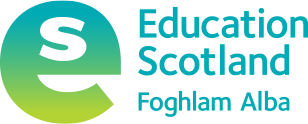Mathematics and numeracy self-evaluation framework: Mathematics and numeracy glossary of terms
The definitions provided in this glossary have been cross referenced with other Education Scotland publications sush as How good is our school appendix 2, Language Matters glossary of terms and Data Glossary of Terms.
Big data can refer to large scale assessment and achievement data that are collected and collated, often at a national or international level.
Examples include: international student assessments, national education statistics, various large-scale surveys etc.
Collaborative learning is when learners work together in pairs or groups to explore concepts, solve problems, or complete tasks. It emphasises active engagement, shared responsibility, and the development of critical thinking, communication and teamwork skills.
Effective collaborative learning fosters deeper understanding through discussion, peer support, and the exchange of diverse perspectives, creating a more interactive and inclusive learning environment.
Concepts are main ideas or sequences of ideas that help to shape understanding. It clarifies meaning and is underpinned by knowledge. Concepts can be grouped or sequenced to develop schema that, for example, allow for the building of relationships in an area such as mathematics.
Culture refers to the shared and modelled attitudes, behaviour and opinions displayed (towards mathematics) within an setting or setting.
Ethos refers to the core values that guide an setting or setting. The ethos helps to shape the policies, commitments, learning environment and aspirations within each school or institution.
Knowledge refers to things that an individual can know. In curriculum it includes substantive knowledge (knowing that) and procedural knowledge (knowing how). Substantive knowledge refers to the understanding of concepts that explain the world (e.g. democracy) and also to individual facts. Procedural knowledge is the knowledge of how to do something (e.g. balance an equation)
Differentiation is the practice of tailoring instruction to meet the diverse learning needs, abilities, and prior knowledge of learners. It involves varying the content, processes, resources, or levels of support to ensure all learners are appropriately challenged and supported.
Effective differentiation in maths and numeracy enables every learner to engage meaningfully with mathematical concepts, develop problem-solving skills, and progress at their own pace while maintaining high expectations for all.
A learning wall is a visual classroom display centred on current mathematical learning. It might include vocabulary, text scaffolds and examples.
Learning walls are intended to be a reference point for learners rather than a static display of their work.
Meta skills are also known as metacognitive skills.
Meta skills are innate, timeless, higher-order skills that create adaptive learners who are able to succeed whatever the future brings.
Modelling is an instructional strategy where the teacher or practitioner demonstrates a skill, process, or way of thinking to support learners in developing their own understanding. It provides a clear example of expectations and approaches, helping learners to internalise strategies before applying them independently.
Effective modelling includes explicit explanation, worked examples, thinking aloud, and guided practice, ensuring learners gain confidence and competence in their learning.
Moderation is the term used to describe approaches for arriving at a shared understanding of standards and expectations. It involves practitioners and other professionals working together, drawing on guidance and exemplification, and building on existing standards and expectations.
Moderation activities could include joint planning of learning, teaching and assessment; reviewing learner evidence and associated teachers’ judgements. It also helps ensure valid and reliable decisions on learners’ progress towards, and achievement of a level, and that assessment criteria are applied consistently.
Non-examples illustrate something that does not fit a specific definition, concept or rule. They are used to provide contrast.
Pedagogy is curriculum enacted and manifested in and through the interactions, experiences and spaces, and times of teaching, learning and assessment.
Provocations are open-ended resources, either materials or objects, that can stimulate thinking and create a context for learners to explore their ideas, either independently or with peers.
Retrieval Practice involves providing frequent opportunities for students to remember what they have learned, purposefully retrieving information from their long-term memory. This approach can support fluency and automaticity and aims to deeply embed knowledge.
Scaffolding is a teaching approach that provides temporary support to help learners develop new skills, understand concepts, or solve problems. This support is gradually reduced as learners gain confidence and independence. Scaffolding can take various forms, including guided questioning, step-by-step demonstrations, visual aids, structured frameworks, and collaborative learning. Effective scaffolding ensures that learners can engage with challenging tasks while building their knowledge and problem-solving abilities.
Technical framework for a curriculum is a set of guidance documents, which practitioners use in order to plan learning for children, young people and adult learners.
Tests of change refer to a structured approach to test small, incremental changes in systems or practices, aiming to build knowledge and improve outcomes through learning from successes and failures. An example of a test of change model is the Plan-Do-Study-Act (PDSA) cycle.
Triangulation is the process used to ensure evaluative statements about strengths and aspects for development are grounded in a robust evidence base.
Triangulation involves bringing together evidence-based information from quantitative data, people’s views and direct observations of practice. Triangulation should involve practitioners, wider staff, learners, partners and other stakeholders.
Variation Theory exposes learners to multiple representations of the same concept. It includes examples of what a concept is and what it is not. It helps learners consider what is kept the same and what changes. This can be through varying problems in small ways to highlight the effects these changes make.
Connections can also be made by exploring a variety of ways to solve the same problem.
